Solar Batteries: Everything You Need To Compare (Cost, Payback, Brands)
By Finn Peacock, Chartered Electrical Engineer, Fact Checked By Ronald Brakels
Last Updated: 31st Dec 2025
The federal battery rebate is being wound back in two steps in 2026: at the start of the year, and again in May. From May, oversized batteries also get hit harder, with much less rebate per kWh. If you’re trying to lock in the best value before the cuts, but still need to brush up on battery basics, this no-nonsense guide has you covered.Solar Batteries Compared
Here’s a table of all the major home batteries on the Australian market that SolarQuotes recommends. As you can see, there’s a lot of choice. The solar battery brands below are arranged according to how frequently they’re searched for on Google, with the most popular appearing first. Scroll left to right to see them all, then scroll past the table to learn more…
| Product Name |
Sungrow SBR HV 16 kWh
|
Tesla Powerwall 3 |
SigenStor Single-Phase (16 kWh)
|
BYD Battery Box Premium HVM 16.6
|
Enphase IQ Battery 5P |
AlphaESS Smile-M5 (10 kWh)
|
SolarEdge Home Battery
|
Neovolt 10 kWh
|
Growatt APX HV 10.0
|
Goodwe ESA 16 kWh
|
ESY Sunhome HM6-10
|
Fox-ESS ECS 9.6 kWh
|
Anker SOLIX X1 15 kWh
|
iStore Smart Battery (10 kWh)
|
Fronius Reserva 12.6
|
Pylontech Force H3X Hybrid (10 kWh)
|
SOFAR PowerAll (10 kWh)
|
SolaX X1 10.2
|
Bluetti EP760 9.9 | FranklinWH aPower X-01-AU |
PowerPlus Energy Whispr 12.7
|
sonnenBatterie Evo | LAVO Storage S2 |
|---|---|---|---|---|---|---|---|---|---|---|---|---|---|---|---|---|---|---|---|---|---|---|---|
| Manufacturer Logo |
 |
 |
 |
 |
 |
 |
 |
 |
 |
 |
 |
 |
 |
 |
 |
 |
 |
 |
 |
 |
 |
 |
 |
| Product Image |
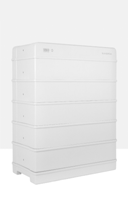 |
 |
 |
 |
 |
 |
 |
 |
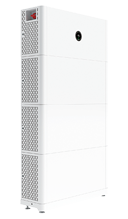 |
 |
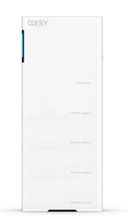 |
 |
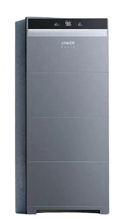 |
 |
 |
 |
 |
 |
 |
 |
 |
 |
 |
| Price incl. federal rebate, excl. installation (AUD RRP, incl. GST) | $6,720 | $9,000 (including Gateway) | $7,700 | $7,600 | $6,900 | $3,600 | $8,200 | $4,600 | $3,700 | $7,400 | $4,000 | $4,000 | $8,400 | $7,200 | $5,900 | $5,000 | $3,000 | $6,300 | $6,000 | $7,900 (including FranklinWH aGate) | $9,500 | $9,100 | $8,000 |
| In Depth Analysis | Yes, review here. | Yes, review here. | Yes, review here. | Not yet. | Not yet | Not yet | Yes, review here. | Not yet | Not yet. | Not yet | Not yet | Not yet | Not yet | Yes, review here. | Not yet | Not yet. | Not yet. | Not yet | Here. | Not yet | (Yes, here.) | Yes, review here. | Not yet |
| Battery Type | Lithium-ion (Lithium Iron Phosphate) | Lithium-ion (Lithium Iron Phosphate) | Lithium-ion (Lithium Iron Phosphate) | Lithium-ion (Lithium Iron Phosphate) | Lithium-ion (Lithium Iron Phosphate) | Lithium-ion (Lithium Iron Phosphate) | Lithium Ion (NMC) | Lithium-ion (Lithium Iron Phosphate) | Lithium-ion (Lithium Iron Phosphate) | Lithium-ion (Lithium Iron Phosphate) | Lithium-ion (Lithium Iron Phosphate) | Lithium-ion (Lithium Iron Phosphate) | Lithium-ion (Lithium Iron Phosphate) | Lithium-ion (Lithium Iron Phosphate) | Lithium-ion (Lithium Iron Phosphate) | Lithium-ion (Lithium Iron Phosphate) | Lithium-ion (Lithium Iron Phosphate) | Lithium Ion (NMC) | Lithium-ion (LiFEPO4) | Lithium-ion (Lithium Iron Phosphate) | Lithium-ion (Lithium Iron Phosphate) | Lithium-ion (Lithium Iron Phosphate) | Lithium-ion (Lithium Iron Phosphate) |
| All-In-One Unit? | No | Yes | Yes | No | No | Yes | No | Yes | No | Yes | Yes | Yes | Yes | No | No | Yes | Yes | Yes | Yes | Kind of. Includes AC battery inverter but requires solar inverter. | Yes | Kind of. Includes AC battery inverter but requires solar inverter. | Yes |
| Nominal Storage | 16 kWh | 14 kWh | 16.12 kWh | 16.56 kWh | 5.0 kWh | 10 kWh | 10 kWh | 10.1 kWh | 10 kWh | 16.64 kWh | 10.24 kWh | 9.6 kWh | 15 kWh | 10 kWh | 12.63 kWh | 10.24 kWh | 10.24 kWh | 10.2 kWh | 9.92 kWh | 15 kWh | 13.37 kWh | 11 kWh | 10.2 kWh |
| Usable Storage Capacity | 16 kWh | 13.5 kWh | 15.6 kWh | 16.56 kWh | 5.0 kWh | 10 kWh | 9.7 kWh | 9.6 kWh | 9 kWh | 16 kWh | 9.73 kWh | 9.3 kWh | 15 kWh | 10 kWh | 12.63 kWh | 9.73 kWh | 9.5 kWh | 9.2 kWh | 8.9 kWh | 13.6 kWh | 12.70 kWh | 10 kWh | 9.7 kWh |
| Features | Modular, expandable | 3 MPPT's, higher output current | Modular, scalable, optional DC EV charger module | Expandable in increments of 2.76 kWh | Modular | UPS, fast response, modular | Modular expansion up to 9 batteries on a system, 90kwh max | Modular, expandable | Modular | Modular, expandable | Modular, expandable | Modular, expandable | Modular, expandable | Modular - expandable | Modular, stackable | Modular | Modular, expandable, 10ms switchover in blackout | Modular, expandable | Modular | Multi-Source Orchestration, supports generator & V2L integration, reinforcing energy security and resiliency. Adaptive Load Control Reliable Black Start with Frequency shifting function enabled | Expandable up to 53.5kWh, true 3-phase backup. | Integrated backup, can charge batteries from solar when grid is down | Modular |
| Power | 9.6 kW | 5kW or 10kW (configurable) | 5 kW | 7.6 kW | 3.84 kW | 5 kW | 5kW steady, 7.5kW peak (10 seconds) | 5 kW | 5 kW | 5-10 kW | 6 kW | Up to 10kW single-phase, 15kW three-phase | 6 kW (AC coupled/single phase) 12 kW (three phase) | 5 kW | 13 kW | 5 kW | 5 kW | Up to 8kW | 7.6 kW | 5kW steady, 10kW peak (10 seconds) | 7kW | 5kW steady , 5.3kW (for 30 min), 7kW peak (for 60 sec) | 5 kW |
| Weight | 180 kg | 130kg | 150 kg | 243 kg | 79 kg | 118.5 kg | 108 kg | 108 kg | 122 kg | 188 kg | 143 kg | 83.5 kg | 175.5 kg | 113.8 kg | 153 kg | 125 kg | 125.5 kg | 134.2 kg | 160 kg | 185 kg | 191kg | 163.5 kg | 122 kg |
| Dimensions (WHD) | 625 x 805 x 330 mm | 609 x 1105 x 193 mm | 850 x 910 x 260 mm | 1644 x 585 x 298 mm | 980 x 550 x 188 mm | 620 x 1,193 x 240 mm | 790 x 1179 x 250 mm | 1120 x 590 x 205 mm | 690 x 1000 x 185 mm | 800 x 952 x 270 mm | 600 x 305 x 998 mm | 570 x 386 x 380 mm | 670 × 1,485 × 150 mm | 670 x 150 x 960 mm | 1,390 x 772 x 176 | 550 x 1046 x 350 mm | 708 x 170 x 1310 mm | 730 × 1226 × 210 mm | 636 x 325 x 1046 mm | 750 x 1150 x 290 mm | 1540 x 750 x 210 mm | 710mm x 1400mm x 427mm | 730 x 203 x 1270 mm |
| Off-grid Capable? | Yes | No | Yes | Yes | TBD | Yes | No | No | Yes | Yes | Yes | Yes | Yes | Yes | Yes | Yes | No | No | Yes | Yes | Yes | TBD | TBD |
| Can charge from the grid? | Yes, if paired with hybrid inverter | Yes | Yes | Yes, if paired with hybrid inverter | Yes | Yes | Yes | Yes | Yes | Yes | Yes | Yes | Yes | Yes | Yes | Yes | Yes | Yes | Yes | Yes | Yes | Yes | Yes |
| Designed for indoor or outdoor installation? (IP rating) | Indoor/outdoor (IP 55) | Indoor/Outdoor (IP 67 for battery and electronics, IP55 for wiring) | Indoor/ourdoor (IP 66) | Indoor/outdoor (IP 55) | Indoor/Outdoor (IP55) | Indoor/Outdoor (IP65) | Indoor/outdoor (IP 55) | Indoor/outdoor (IP 65) | Indoor/Outdoor (IP 66) | Indoor/outdoor (IP 66) | Indoor/outdoor (IP66) | Indoor/outdoor (IP 65) | Indoor/outdoor (IP 66) | Indoor/outdoor (IP 66) | Indoor/outdoor (IP 65) | Indoor/Outdoor (IP 65) | Indoor/outdoor (IP 65) | Indoor/Outdoor (IP66) | Indoor/Outdoor (IP65) | Indoor/Outdoor (IP67 (Battery and power converter system), IP56 (Wiring compartment) | Indoor/outdoor (IP65) | Indoor/Outdoor (IP 56) | Indoor/Outdoor (IP 65) |
| Operating temperature range | -30°C to 50°C | -20°C to 50°C | -20 ~ 55 °C | -10 °C to +50°C | -20º C to 50º C | -10 to 50°C | -10-℃~ + 50℃ | -20°C - 60°C | -10 to 50°C | -18 to +55°C | -25°C-60°C | Charge: 0 ~ 55°C Discharge: -10 ~ 55°C | -20°C to 55°C | -20-℃~ + 55℃ | -20 to +55 °C | -10 to 55°C | -10 °C to +50°C | -30 to 55°C | -20℃~50℃ | -20°C to 50°C | -20 to 55°C | -5 to 45 °C | -20°C ~ 54°C |
| Warranty | 10 years | 10 years | 10 years | 10 years | 15 years | 10 years | 10 years (unlimited cycles) | 10 years | 10 years | 10 years | 10 years | 10 years | 10 years | 10 years | 10 years | 10 years | 10 years | 10 years | 10 years | 12 years | 10 years | 10 years | 10 years |
| Battery capacity remaining at end of warranty | 70% | 70% | 70% | 70% | 70% after 10 years and 60% from 10-15 years | 70% | 70% | 70% | 50% | 70% | 60% | 70% | 70% | 70% | 70% | 60% | 70% | 70% | 70% | 70% | 70% | 80% | 60% assumed |
| Compatible hybrid inverter brands (If not an all-in-one unit) | Sungrow | N/A | N/A | Fronius | N/A | N/A | SolarEdge | N/A | Growatt | N/A | N/A | Fox-ESS | Anker SOLIX | iStore | Fronius | N/A | N/A | N/A | N/A | N/A | N/A | N/A | N/A |
| Total warranted kWh (1 cycle per day) | 44,800 | Unlimited cycles for self consumption / Time based control / backup. 37,800 kWh for other uses | 47,540 | 51,230 | 27,375 | 31,200 | 35,405 | 38,380 | 27,000 | 48,000 | 35,514 | 39,320 | 42,000 | 32,900 | 39,140 | 35,500 | 36,500 | 31,800 | 32,485 | 43,000 | 35,560 | 36,500 | 35,405 |
| Warranted usable throughput per kWh | 2.8 MWh | Unlimited (regular use) / 2.8 MWh (other use) | 3.05 MWh | 3.1 MWh | 5.4 MWh | 3.12 MWh | 3.65 MWh | 3.65 MWh | 3 MWh | 3 MWh | 4.42 MWh | 4.22 MWh | 2.8 MWh | 3.3 MWh | 3.1 MWh | 3.65 MWh | 3.65 MWh | 3.45 MWh | 3.65 MWh | 3.1 MWh | 2.8 MWh | 4.1 MWh | 3.65 MWh |
| Datasheet Supplied? | Yes | Yes | Yes | Yes | Yes | Yes | Yes | Yes | Yes | Yes | Yes | Yes | Yes | Yes | Fronius Reserva datasheet | Yes | Yes | Yes | Yes | Yes | Yes | Yes | Yes |
| Warranty Supplied? | Yes | Yes | Yes | Yes | Yes | Yes | Yes | Yes | No | Yes | Yes | Yes | Yes | Yes | Fronius Reserva warranty | Yes | Yes | Yes | Yes | Yes | Yes | Yes | Yes |
| Cost per Total Warranted kWh (1 cycle per day) | $0.15 (+ inverter cost) | $0.25 | $0.16 | $0.15 (+ inverter cost) | $0.25 | $0.12 | $0.23 | $0.12 | $0.12 (+ inverter cost) | $0.15 | $0.11 | $0.10 | $0.19 | $0.22 (+ inverter cost) | $0.15 (+ inverter cost) | $0.14 | $0.08 | $0.20 | $0.18 | $0.19 (+ inverter cost) | $0.24 | $0.25 | $0.23 |
| On our recommended chart? | Yes | Yes | Yes | Yes | Yes | No | Yes | No | No | No | No | No | No | Yes | Yes | No | No | No | No | No | Yes | No | No |
| Modern slavery statement or forced labour policies? | Yes, here. |
Claims to have a plan to manage the risks, but details have not been provided. |
TBD | Failed to respond | TBD | TBD | TBD | TBD |
Yes, here (covered under Shell's). |
No response from manufacturer. |
|||||||||||||
| More information on brand | Here | Here | Here | Here | Here | Here | Here | Here | Here | Here | Here | Here | Here | Here | Here | Here | Here | Here | Here | Here | Here | Here | Here |
See the glossary for an explanation of each row on the table.
Which Solar Battery Is Best?
Every year, I ask hundreds of Australian battery installers to vote on the best home batteries based on what they’d install on their own homes. For the best home batteries in 2025, Tesla and Sungrow tied for first place, marking a big shift – Tesla had dominated the top spot since 2021. Sigenergy made an impressive debut in second place, and BYD slipped to third after being the runner-up last year. However, it might be the last year for BYD, since Fronius has released its own Reserva battery.
Now you know which batteries installers prefer, but what brands do the Australian people like? Find out on our top 10 best solar battery brands according to Australian reviewers.
You won’t go wrong if you get one of those installed by a good electrician, and you understand the payback. Other brands we can recommend are on the chart below.
Table Of Contents
- Solar Batteries Compared
- Which Solar Battery Is Best?
- How Much Does a Solar Battery Cost?
- How Much Can a Battery Save Me?
- Are Solar Batteries Worth It?
- Am I Eligible for Any Battery Rebates?
- Which Battery Systems Protect Against Blackouts?
- Why Are Lithium-ion Batteries Best?
- What Will A Battery Look Like On My Home?
- Where Should I Install My Battery?
- Does It Matter Where I Live?
- Watch A Professional Battery Installation
How Much Does a Solar Battery Cost?
A decent-sized (10kWh) solar battery starts at about $7,000 before installation. Our solar battery price grid lets you arrange the brands from our comparison table above according to price (as well as rating, popularity and name).
The prices include the Federal Battery Rebate. This cuts the cost of installed batteries by around 30% and is available throughout Australia.
WA also has an additional state battery rebate that can be combined with the federal rebate for extra savings.
Besides rebates, the price tag hinges on two key elements:
- Energy storage capacity, measured in kilowatt-hours (kWh) – more energy storage, higher cost. Most households will want 10kWh or more.
- The brand reputation – because not all batteries are created equal.
On top of the hardware cost, the batteries must be installed professionally. DIY electrical work is not allowed in Australia.
What Does A Battery Cost To Install?
A simple battery installation normally adds at least $2,000 to a quote. A complicated battery installation (longer cable run, bollards for a garage, fireproof backing, etc.) can be $3,000 or more.
Cost Of An Installed Solar Battery:
| Category | Brand | Model | Capacity | Approx Installed Cost | After Federal Rebate |
|---|---|---|---|---|---|
| Budget | AlphaESS | Smile5 | 13.3 | $11,000 | $6,600 |
| Mid-range | Sungrow | SBR | 12.8 | $11,200* | $7,000* |
| High-End | Tesla | Powerwall 3 | 13.5 | $16,100 | $11,650 |
If you’re in WA, the WA battery rebate can make these prices even lower.
Wondering if a battery is worth it? Check out the full battery cost analysis.
Don’t Match A Huge Battery With A Tiny Inverter
Cheap deals on giant 30-50 kWh batteries are everywhere now, thanks to the federal rebate. The sting in the tail is that many of them are paired with a tiny 5 kW inverter. That small inverter throttles how fast the battery can charge from solar and how much power it can supply at once. In the real world, that means you can be sitting on a massive battery, but still dragging plenty from the grid whenever the house or EV needs a decent burst of power.
If you’re looking at a “big battery, small inverter” quote, don’t just check the storage size (kWh) – make sure the inverter power (kW) matches how you actually use energy at home, especially for air conditioning, hot water heating and EV charging. Read our in-house installer Anthony’s full breakdown of this “big battery with a small inverter” trap.
Do I Need to Replace My Solar to Add a Battery?
Not sure if you need to replace your existing solar system to add a battery? The flowchart below will help you quickly figure out if your current setup can work with the federal battery rebate — or if you might need some upgrades.

With a solar battery setting you back thousands of dollars, the next question is – how quickly will those dollars return to your pocket?
How Much Can a Solar Battery Save Me?
Battery payback can vary from ‘no-brainer’ to ‘not bloody worth it’ depending on factors including:
- your solar array size,
- your electricity usage,
- your electricity tariff,
- what battery you buy and how it’s installed.
Be wary of aggressive sales tactics. Always do your research before making a decision. Don’t buy from door-knockers or unsolicited mailings.
If you already have solar and want to know if adding a battery is worth it financially, my ‘add-a-battery calculator‘ is your go-to. Using your smart meter data, it’ll work out how much spare solar you have for charging and how much energy you use overnight to give you an accurate battery payback period.
But if you’d rather skip the number-crunching, I’ll walk you through some ballpark payback figures.
For example, if you pay $11,000 to have a Sungrow SBR HV battery with 16kWh of storage installed, here are the savings and payback periods a household in NSW could expect to see in both a best-case situation as well as for a more realistic outcome for a typical household1.
| Sungrow 16kWh | Annual Savings: Flat rate | Annual Savings: Time-of-use |
|---|---|---|
| Best-case savings | $1,658 | $2,631 |
| Best-case payback | 6.6 years | 4.2 years |
| More realistic savings | $1,290 | $1,548 |
| More realistic payback | 8.5 years | 7.1 years |
In the more realistic situation with a time-of-use tariff, the savings will be roughly similar in NSW, SE QLD, SA and WA. In the ACT and VIC, savings will be roughly one-third less. In Tasmania, the savings will only be around one-third as much as in NSW, making it the state with the lowest financial return from installing a battery.
The results show how battery households are normally much better off on a time-of-use tariff than a flat tariff.
Changes in guidelines now allow for more flexible solar setups, making it easier to install a large solar system at the same time as a battery. The larger your solar system, the better your battery payback will generally be.
Flat Rate Tariffs & Solar Batteries
In simple terms, a flat rate tariff means you’re charged the same price for electricity, no matter what time of day it is – usually around $0.35 for each unit of electricity (or kWh).
With a solar battery, you can store solar energy during the day and use it at night. Each unit of stored solar energy you use saves you the cost of buying that unit from the grid. However, keep in mind that using your stored energy means you’re also missing out on the money you’d earn by sending that energy back to the grid – a.k.a. the feed-in tariff.

A flat rate tariff charges one rate all day, every day.
So, if you pay $0.35 for grid electricity and your FiT is $0.07, you save $0.28 per kWh of battery energy used at night. Many people – and some dodgy sales folk – forget to subtract the foregone feed-in-tariff when calculating their savings.
Time-Of-Use-Tariffs & Solar Batteries
Time-of-use (ToU) tariffs have two or more rates, the most expensive being in the late afternoon and evening when electricity can be as high as $0.75 per kWh. Most of your battery savings will come from avoiding the peak price period.
Some ToU tariffs charge as little as $0.08 for daytime electricity, so you can top up your battery cheaply, even if there is not enough solar power available.
With some ToU tariffs, late-night rates can be around 20 cents cheaper than in the morning. On these plans, you can top up your battery overnight to ride through the morning peak.

This particular ToU plan is Synergy’s Midday Saver, available in WA.
Some compellingly cheap time-of-use tariffs are only available to owners of specific brands. For example, Energy Locals’ Tesla Energy Plan is for Powerwall owners only.
Getting Clever: Playing The Wholesale Market
One electricity retailer (Amber) exposes you to wholesale electricity pricing that varies every fifteen minutes. The price can go over $18 per kWh – which is terrible if you need to use grid electricity – but great for selling back to the grid.
On the flip side, prices can go so low they go negative, which means you get penalised for exporting energy and paid to use energy (a great time to charge a battery). It’s a high-stakes game for serious players only. But if you want to play it, I know people who have made over $2,000 in one year using Amber tariffs.
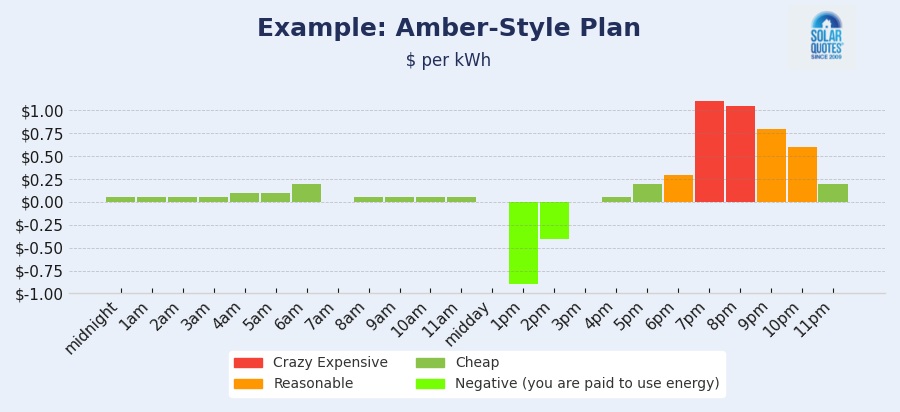
This is what your average hourly rate could be on a wholesale-exposed plan such as Amber Electric.
Now you know how batteries save you money, we can answer the $10,000 question…
Are Solar Batteries Worth It?
On a flat tariff – not so much.
As you can see in the table above – a 14.5 year payback with a Powerwall on a flat tariff is typical. In my experience, that’s too long for most, although you can improve your payback by getting a rebate, joining a VPP, optimising your tariff or buying a cheaper battery (but don’t go too cheap).
But on a time-of-use tariff, it’s much better.
If you are on a time-of-use tariff and can get a 6-7 year payback, home energy storage starts to look like a good investment – especially if you value any of these bonus reasons for investing in a battery:
- Protection from blackouts
- Being green (by supporting a more renewable grid)
- Revenge (you hate energy companies)
- Love (you love owning the latest tech)
I’ve written a detailed answer to ‘Are Solar Batteries Worth It?‘, which considers where you live, what tariff you are on, and what local VPPs are available to you.
Am I Eligible for Battery Rebates?
Battery rebates make batteries cheaper, improving payback.
National Battery Rebates?
An Australia-wide federal battery rebate aims to lower home battery costs by around 30%. The overwhelming popularity of the Cheaper Home Batteries Program threatened to deplete the allocated funding early. That is why the rebate has been adjusted, with restrictions on bigger-than-necessary batteries. In a nutshell:
-
The rebate value drops faster: it now steps down twice a year (not yearly) starting 1 Jan 2026.
-
In May, the scheme changes again. Not only the value drops, but big batteries get less support: the rebate becomes tiered, so larger capacities attract a much lower $/kWh subsidy (especially the 30–50 kWh “package deal” sizes).
-
Caps still apply: systems can be 5–100 kWh nominal, but the rebate only applies to the first 50 kWh usable.
-
Bottom line: normal household-sized batteries lose some value, but oversized batteries lose a lot more once the May 2026 tiers kick in.
State/Territory Rebates?
The federal battery rebate to be compatible with state and territory rebates. Currently, WA is the only state that offers a rebate.
- Western Australia’s Residential Battery Scheme is worth up to $130 per kWh for up to 10 kWh of storage capacity, or $380 in regional WA. You are required to join a VPP.
Subsidised Battery Loans
- ACT offers an interest-free $15,000.
- WA will offer interest-free loans of up to $10,000 as part of its Residential Battery Scheme.
Find out more about how these rebates and loans work on our in-depth Battery Rebates page.
VPP Rebates
Local government subsidies aren’t the only way to get a cheaper battery. Some virtual power plants give you an upfront discount on a new battery:
| VPP | Battery Subsidy | Eligible Areas |
|---|---|---|
| Origin Loop | $1,500 | SYD, BRIS, MELB, GOLD COAST metros (50km radius) |
| Tesla/SA Govt | Free Powerwall | Housing SA properties only |
| Simply Energy | $800 | SA, VIC, NSW, QLD |
| SolarHub | $4,950 | Specific NSW Council areas |
The downside is you lose control of your battery, and it is is worked harder – which can shorten its lifespan.
Nerd Fact: A Virtual Power Plant (VPP) is a collection of internet-connected residential batteries controlled by an energy company. This army of batteries charge and discharge in unison to support the grid.
Pro-tip: My Virtual Power Plant comparison table details every VPP available in the country.
I’ve been talking a lot about costs and returns, but let’s not lose sight of another massive perk – resilience. In an age of wild weather and unpredictable blackouts, a solar battery can be your home’s safety net, keeping the lights on when the grid throws in the towel.
You’ll be surprised to learn that not all batteries come with backup, and not all backup is equal. Here’s what you need to know if blackout protection is important to you…
Pro-Tip: The New South Wales Government has an additional VPP incentive of $55 per kWh of battery storage up to 10 kWh. This VPP incentive is what remains of the NSW battery rebate that got scrapped.
Which Battery Systems Protect Against Blackouts?

Finn’s house during a blackout
Most solar batteries available in Australia promise to keep you powered up during a blackout. But not all are created equal. Here are the must-know features that could make or break your blackout resilience:
- Backup Current: Measures how many gadgets and appliances you can keep running simultaneously.
- Surge Current: Check if the battery can handle the initial power spike when you start up an appliance.
- Switchover Time: The momentary blackout you’ll experience when switching from grid to battery – this can range from milliseconds to a few minutes.
- Solar Charging Without the Grid: Some systems cut off your solar charging capabilities when the grid’s down – watch out for this.
- Failsafe Design: If the battery’s inverter goes kaput, will it mess with your regular grid supply?
An experienced installer is your best mate in navigating these intricacies. And remember, if you’re eyeing a budget battery, scrutinising these features is even more crucial.
Pro-tip: Some cheaper battery systems can interrupt the grid power to your essential circuits if the inverter hardware fails. Always install a $100 battery bypass switch to override it and keep the lights on if there’s a problem.
Whole Home Backup
Buying a battery system to back up an entire Australian home costs big dollars. I recommend saving thousands by choosing a handful of essential circuits and backing those up. For example:
- Fridge (no one likes spoiled food)
- Lights (for obvious reasons)
- A few sockets, including one for your internet router (stay connected)
- Small air conditioner (because our summers are no joke)
By zeroing in on these essentials, you’ll get the most bang for your buck and still keep things civilised when the grid goes down.
Why Are Lithium-ion Batteries Best?
Wondering why Lithium-ion is the go-to for solar batteries? Let’s delve into that next.
Almost all grid-connected solar batteries in Australia are lithium-ion because they:
✅ store more energy by weight and volume
✅ are higher power by weight and volume (can charge and discharge faster)
✅ are more efficient – typically only losing 10% of energy when charged and then discharged
✅ are maintenance-free
✅ last longer than older lead-acid battery technology
✅ don’t require excessive amounts of space, fitting easily into most homes
The biggest disadvantage of Lithium-ion batteries is:
❌ in the unlikely event they catch fire, they burn like hell
Types Of Lithium-ion Solar Battery
Unless you want to go mega niche, you can choose from 3 types of solar batteries (all sub-types of lithium-ion):
- NMC
- LFP
- LTO
| Lithium-ion sub-type | Battery Brands | Pros | Cons |
|---|---|---|---|
| Nickel Manganese Cobalt: NMC2 | Tesla Powerwall 2, LG Chem, SolarEdge, Q-Cells |
High capacity. High power. Less capacity loss in the first year. |
Catch fire more easily |
| Lithium Iron Phosphate: LFP | BYD, Sungrow, Enphase, Goodwe, Alpha ESS, and most other brands on the Australian market |
Catch fire less easily. ~30% cheaper3. Life = ~15% longer than NMC4. |
Lower capacity than NMC. Lose more capacity in the first year. |
| Lithium Titanate Oxide: LTO | Zenaji |
Claimed to last twice as long as NMC or LFP. It is claimed to be one of the safest lithium chemistries, but at least one is reported to have caught fire in NSW5 |
Lowest capacity6. Most expensive. Niche manufacturer. |
Insider-tip: The Powerwall 2 is an NMC battery, but the Tesla Powerwall 3 has LFP battery cells and an integrated 11.3kW solar inverter – making it a true all-in-one battery system (see below).
What Will A Solar Battery Look Like On My Home?
Your solar battery’s aesthetics will depend on whether it is:
- an all-in-one system
- a separate battery and inverter
- a Powerwall 3 (which is a mixture of the above)
All-In-One Battery Systems
An all-in-one solar battery system contains almost everything you need in one big box:
- battery
- battery inverter
- solar inverter
- backup switchover
In the marketing materials, you’ll see them with zero wires attached. Reality is not as neat:

In reality, you need isolating switches, power, comms cables, warning stickers and – if in a garage – a bollard. Install: JCW Electrical
Separate Battery & Inverter
A separate battery and battery inverter won’t look as tidy as a well-installed all-in-one, but a good installer can keep everything neat:
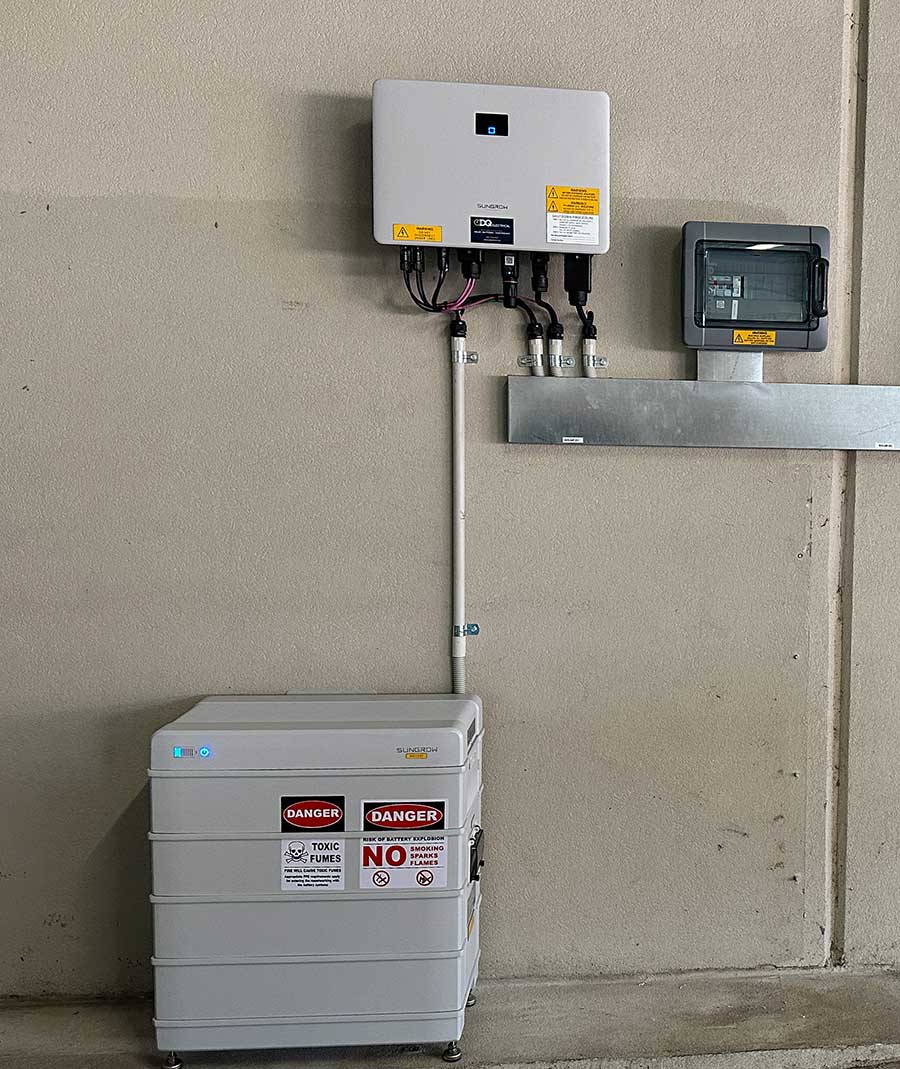
A separate Battery (bottom) and hybrid solar/battery inverter (top). Note the use of ducting and hard conduit to keep it neat. The grey box is a small switchboard for backup circuits and breakers.
Powerwall 3
The Powerwall 3 is almost all-in-one. It has a built-in solar inverter, so you can plug up to 20 kW of solar panels into it. However, it still needs the same Gateway box as the Powerwall 2 to handle backup and monitoring. Powerwall 3 is a good choice if you are buying your battery and solar array at the same time.

A Tesla Powerwall 3 safely installed in a South Australian garage. Install Credit: Goliath Solar and Electrical
Modular Batteries
Modular batteries are stackable or connectable units that you can add to over time as your energy needs grow. Unlike monolithic systems like the Powerwall 3, which come in one fixed size, modular batteries are designed to be lightweight, compact, and easier to install.
These batteries don’t just perform well – they look good too. Most resemble sleek building blocks that can stack vertically or connect horizontally, depending on the design. Popular modular battery brands include BYD and Sungrow.

This Sungrow SBR HV modular battery, undergoing installation, currently has a stack of four 3.2kWh battery modules.
Where Should I Install My Solar Battery?
Australia has strict standards for how and where batteries are installed – specifically Australian Standard AS5139. You don’t need to understand the electrical details, that’s the sparky’s job – but you do need to know how it affects where you can put it.
For example, places you can’t put a battery include:
- within 600mm of a window
- under the floor of a habitable room
- on a wall shared with a habitable room without a ‘non-combustible’ barrier
And you definitely can’t put one in your dining room, like some battery brochures would have you believe:

Don’t do this. Image: Soltaro battery brochure
Does It Matter Where I Live?
Australia’s a big country, and where you live can factor into which battery is best for you…
Climate
The closer you live to Melbourne or Hobart, the lower your annual solar production, so you’ll need a larger solar system to reliably charge a battery all year.
At the other extreme, heat is the #1 thing that will shorten your battery’s life. So keep it cool if you live in a particularly sunburnt part of Australia, and check its ambient temperature range in the battery comparison table at the top of this page before buying.
Electricity Tariffs
‘Solar sponge’ electricity plans, which can boost battery payback, and allow you to charge cheaply from the grid on low solar days are currently only available in WA, SA and QLD. But they’re likely to appear in other states soon.
Rebates/subsidies/VPPs
Certain government battery rebates, interest-free loans, or Virtual Power Plants are area-specific.
Grid Connection Rules Around Battery Inverters
Some local DNSPs (Distributed Network Service Providers), like Essential Energy, still make it hard to add a battery inverter if you already have a solar inverter. A good local installer will be all over these rules.
Watch A Professional Solar Battery Installation
Installing a solar battery isn’t just a matter of connecting a few wires and it usually takes two people one day. It’s a precise job that requires planning, compliance with Australian standards, and a licensed electrician. Whether you’re upgrading your current solar setup or going hybrid, the goal is to keep your home running smoothly – even during a grid outage.
The battery is mounted securely (on the wall or floor) and connected to an inverter – either your existing hybrid one or a new battery inverter. The key is seamless integration with your solar panels and grid for maximum safety and performance.
Want to see how it’s done? Watch the video below for a behind-the-scenes look at a professional installation, from setup to final handover.
Useful Battery Tools
Solar & Battery Calculator
My solar & battery calculator estimates the savings and payback of solar and batteries for your situation. Crucially, it separates out the solar and the battery savings, so you can decide if home energy storage is worth the extra dollars.
Add a Battery Calculator
If you already own a solar panel system but want to calculate the potential savings of adding a battery, you can use my “Add a battery” calculator.
Battery Reviews
Read expert solar battery reviews and browse customer reviews for most battery brands sold in Australia.
Hybrid Inverter Comparison Table
Installing a hybrid inverter to control both your solar panels and your solar battery can save you money because you only need one expensive (~$2000) inverter. Here is a table comparing all hybrid inverters we know of available in Australia. If you choose one of these for your solar installation, adding batteries can be cheaper and easier in the future.
Battery 101 Guides
Understanding Batteries 101: This is a more in-depth guide aimed at technical understanding of home batteries, delving into how they work and comparing different technologies like lead-acid and lithium-ion. It also explains the difference between power and energy in the context of batteries and discusses integrating a battery with a solar system using AC or DC coupling.
Buying Batteries 101: If you are serious about buying a solar battery – you should read this guide (or watch the video) so you can go toe to toe with any salesperson and get the right battery system at the right price.
Owning Batteries 101: Once your solar battery is installed, here’s what you need to know for a decade or two of cheap, secure power.
FAQs
If you are on a single-rate tariff, you want enough capacity to get you from sunset to sunrise. If you are on a Time-Of-Use tariff, you must get through the evening peak – typically 4 pm – 10 pm. You can usually see your hourly usage through your electricity retailer’s online portal.
Remember that most battery owners keep a 20% ‘reserve margin’ on top of that in case of a blackout. So a 10 kWh battery would have 2 kWh reserved for blackouts and 8 kWh for powering your home.
Some prefer to maximise the financial return from their batteries by not setting a reserve. There will usually be some energy in the battery when a blackout occurs, but it runs the risk you’ll wind up sitting in the dark.
Smaller batteries cost more per kWh of usable storage. This means you may be better off getting a larger one despite your low electricity usage.
Here’s an even more detailed answer: How many solar batteries do you need?
If you have access to a grid connection, do not go off-grid. Grid-connected solar and battery systems start at around $6,000. Dependable off-grid systems for typical Australian homes start at around $60,000 and require regular checks, careful energy management, and generator backup.
The size of home batteries depends on their energy capacity and their ‘specific energy’, which measures how much capacity they can squeeze into a given volume. If space is an issue, Tesla and Sungrow make space-efficient batteries, whereas the Enphase solution is bloody huge. More details on battery dimensions here.
A study in the journal Energies says in moderate climates (20–32°C) with daily use, lithium batteries should last 14–16 years. In climates up to 40°C, expect 12–14 years. Warranties range from less than two years (if you read the small print on some cheap batteries) to 15 years for some NMC and LFP batteries and 20 years for more expensive LTO chemistry. More details on how long batteries last here.
Those who join the Tesla Energy Plan VPP and stick with it will have their Powerwall 2 warranty extended by 5 years. This suggests Tesla expects their home batteries to last at least 15 years.
Every year, I survey our network of ~600 installers and ask them. In 2025, Tesla and Sungrow tied for the best battery, followed by Sigenergy and BYD.
Yes. Home battery recycling is an emerging industry – because there are not many at the end of their life yet – but the technology exists to recycle over 90% of a home battery. When yours finally dies, contact your installer or the manufacturer for details.
Yes. Although extremely unlikely, I’m not gonna lie. If a lithium-ion solar battery catches fire, it will burn ferociously and can release nasty gases, which may include phosphorus pentafluoride, phosphoryl fluoride and hydrofluoric acid vapours.
You do not want to breathe these in – so evacuate the area and contact emergency services. Remain upwind and notify those downwind. No one should go near a smoking or burning home battery without full protective equipment, including Self Contained Breathing Apparatus (SCBA).
I’ve written a whole page on home battery safety if you are concerned.
NO! A battery will only lose money if your feed-in tariff exceeds your usage tariff — provided the solar system is a reasonable size. If it’s only small, you can be better off with a large new solar system and a battery.
Yes. They usually go on your home insurance, not your contents insurance, because they are hardwired into your home. Just call your insurer and let them know you’ve added a home battery.
No. You can happily use a single-phase battery on one phase of a three-phase home, but there are some 3-phase battery details you should know.
A ‘battery-ready’ solar system is a grid-connected solar power system designed for easy future integration of batteries.
It depends entirely on the size of your house, how you condition the spaces, how you heat water, and how many residents. The best way to know is measure your existing overnight consumption either with a solar consumption meter, monitoring like CatchPower or data from your utility smart meter.
Sizing a battery to cover your average demand from around 3 pm to 9 am is the normal approach, but you must also ensure there is enough solar yield to power the daytime loads and enough surplus to fill the battery.
It’s especially critical to consider winter. When heating loads are high and solar generation is low you’ll want a lot more panels on the roof.
A battery under 10 kWh can suit households with low overnight electricity consumption or those who want the fastest payback period possible. But for most households, I recommend over 10 kWh because – so long as you have enough solar – it will minimise your grid electricity consumption and allow you to live through most blackouts with ease.
A solar battery is any battery designed to store energy from solar panels. That includes everything from small off-grid setups to large commercial and utility-scale systems. A home battery is simply a type of solar battery made for residential use. So, while all home batteries are solar batteries, not all solar batteries are home batteries. On SolarQuotes, when we talk about solar batteries, we’re almost always talking about home batteries: the kind you can install at your place to store excess solar and use it later.
Glossary
Battery Comparison Table Rows
Price: Our best retail price estimate includes GST. For the required hardware only.
Battery Type: Either LFP, NMC or LTO. See here for an explanation of the differences.
All-in-one-unit: See here for a pictorial explanation of the difference between an all-in-one, a separate battery and inverter and a Powerwall.
Nominal Storage: How many kWh a battery can store in theory. In practice, most won’t let you use all their energy capacity in order to prolong their lifespan.
Usable Storage Capacity: How many kWh you can store in a battery in practice.
Power (kW): The speed at which a battery can charge and discharge. Check yours doesn’t limit this in backup mode.
Round Trip Efficiency: When you put a kWh in, how much do you get back out? Typically 90%.
Ambient temperature range: What air temperature is the battery rated for? If it gets too cold or too hot, performance can take a hit, or the warranty can be reduced, or both.
Off-grid capable: Does the manufacturer warrant the battery for off-grid?
IP Rating: How well sealed from the elements is the battery? Can it go outside?
Compatible Hybrid Inverters: A hybrid inverter is required for some battery systems – these are compatible ones. A hybrid inverter can also manage your solar panels – potentially saving a couple of thousand bucks.
Warranty: the headline warranty – before caveats. Sometimes this is shortened depending on how hard you work the battery.
Battery capacity remaining at end of warranty:This is how much of the original capacity you can pull from the battery under warranty. For example, a 10kWh battery that warrants 70% capacity at the end of 10 years would give you 7kWh.
Warranty length (1 cycle per day): How long is the warranty if you fully discharge the battery every day? Those on a flat tariff rarely cycle theirs more than once per day.
Warranty length (1.5 cycles per day): If you fully discharge the battery 1.5 times every day, how long is the warranty? This is typical for time-of-use tariffs where you charge during the day to get through the evening peak, and then again at night to get through the morning peak.
Cost Per Warranted kWh: 1 Cycle Per Day: If the battery cycles once per day, this is how much each warranted kilowatt-hour of stored electricity will cost. It exposes good and bad warranties.
Modern Slavery/Forced Labour: Does the manufacturer have policies addressing modern slavery/forced labour risks.
Home Battery Quotes
If you’re ready to buy a solar battery, I can help you get quotes for quality home energy storage systems from pre-vetted installers quickly and easily:
- Assumptions: The battery is charged with solar and has a 90% roundtrip efficiency. In the best-case situation, 90% of the battery capacity is discharged each day, and with a time-of-use tariff, it’s all during the peak period. In the more realistic situation, 70% of the battery capacity is discharged each day. With a time-of-use tariff, 40% is discharged during the peak period and 30% during the shoulder. The flat electricity rate is 36c with a 4c feed-in tariff. Peak electricity is 54.5c, shoulder electricity is 26c, and the solar feed-in tariff is 4c. ↩
- Most likely a mixture of NMC, NCA & LCO – source Powerwall MSDS. ↩
- LFP cells were 30% cheaper for stationary energy storage than other lithium chemistries in 2024. ↩
- Hector Beltran, Pablo Ayuso, and Emilio Pérez, Lifetime Expectancy of Li-Ion Batteries Used for Residential Solar Storage ↩
- Source: NSW Fire & Rescue Page 5 ↩
- Source: Battery University ↩
